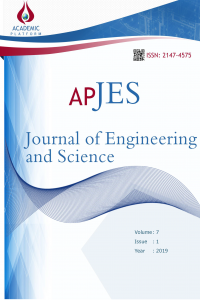Abstract
The correct understanding of the conceptual and practical content of Industry 4.0 is of great importance since global competition necessitate technology based manufacturing. Industry 4.0 refers to revolutionary developments in the form of production based on technological developments that allow for more flexible, more efficient and higher quality production than conventional production methods. However, Industry 4.0 studies have not yet reached sufficient expositional level in regard to the context. Despite the fact that there are a few studies in the literature on how to determine the Industry 4.0 levels of companies, no study is found about suggesting how this level will change in the future. The aim of this study is to propose a model that will predict the companies' existing and anticipated Industry 4.0 levels. In the study, a model that predicts the Industry 4.0 level was developed using the IMPULS model criteria and the Fuzzy Cognitive Maps method.
References
- M. Blachet, T. Rinn, G. V. Thaden, And G. Thieulloy, “Industrıal 4.0: The New Industrial Revolution: How Europe Will Succeed,” pp. 24, 2014.
- M. Hermann, T. Pentek, And B. Otto, “Design Principles for Industrie 4.0 Scenarios,” 2016, pp. 3928–3937.
- A. Schumacher, S. Erol, And W. Sihn, “A Maturity Model for Assessing Industry 4.0 Readiness and Maturity Of Manufacturing Enterprises,” Procedia CIRP, Vol. 52, pp. 161–166, Jan. 2016.
- K. Lichtblau, V. Stich, R. Bertenrath, M. Blum, M. Bleider, A. Millack, K. Schmitt, E. Schmitz, and M. Schröter, “IMPULS - Industrie 4.0- Readiness,” Impuls-Stiftung des VDMA, Aachen-Köln, 2015.
- “Befähigungs Und Einführungsstrategien Für Industrie 4 0 Vorstellung - Technische Informationsbibliothek”
- “The Connected Enterprise Maturity Model,” Rockwell Automation.
- PricewaterhouseCoopers, “The Industry 4.0: Digital Operations Self Assessment,” 2016.
- Rockwell Automation, “The Connected Enterprise Maturity Model,” Rockwell Automation.
- “Institut Für Intelligente Produktion,” Fh - Oberösterreich.
- “Industry 4.0: Building The Digital Enterprise,” Pricewaterhousecoopers, 2016.
- U. Asan, A. C. Kutlu, and C. Kadaifci, “Analysis of Critical Factors in Energy Service Contracting Using Fuzzy Cognitive Mapping,” Proceedings of The 41st International Conference on Computers and Industrial Engineering, 2011.
- A. Şahin, “Time Series Forecasting Via Computational Intelligence Methods,” İstanbul Teknik Üniversitesi, 2016.
- F. Z. Uslu, “Yumuşak Doku Sarkomlarının Sınıflandırılmasında Bulanık Bilişsel Haritaların Uygulanması - Ulusal Tez Ve Araştırma Merkezi - Akademik Tezler ve Araştırmalar,” Erciyes Üniversitesi, 2011.
- Ö. Uygun, E. F. Erkan, and B. Topçuoğlu, “Bulanık Bilişsel Haritalar Temelli Yeşil Tedarik Zinciri Yönetimi Değerlendirme Modeli,” 3rd International Symposium Environment and Morality (ISEM2016) 4-6 Nov 2016 Alanya/Antalya-Turkey, 2016.
- M. E. C. Bagdatli, “Karayolu Projelerinin Fayda-Maliyet Analizleri İçin Risk Eklentili Yeni Bir Bulanık Bilişsel Harita Modeli,” Doktora Tezi, Sakarya Üniversitesi, 2016.
IMPULS Kriterleri ile Endüstri 4.0 Eğiliminin Değerlendirilmesi: Bir Bulanık Bilişsel Harita Uygulaması
Abstract
Küresel rekabet teknolojiye dayalı üretimi bir zorunluluk haline getirdiği için Endüstri 4.0'ın kavramsal ve pratikteki karşılığının doğru anlaşılması büyük önem arz etmektedir. Endüstri 4.0 geleneksel üretim yöntemlerine kıyasla daha esnek, daha verimli ve daha kaliteli bir üretimin gerçekleşmesine imkan sağlayan ve teknolojik gelişmelere dayalı üretim biçimindeki devrimsel gelişmeleri ifade eder. Ancak Endüstri 4.0 ile ilgili çalışmalar konunun anlaşılması açısından henüz yeterli açıklayıcılığa sahip değildir. Firmaların Endüstri 4.0 seviyelerini belirlemeye yönelik literatürde birkaç çalışma olmasına rağmen, gelecekte bu seviyenin nasıl bir seyir izleyeceği konusunda fikir veren bir çalışmaya rastlanmamıştır. Bu çalışmanın amacı firmaların Endüstri 4.0 seviyelerini öngörecek bir model oluşturulmasıdır. Çalışmada IMPULS modeli kriterleri ve Bulanık Bilişsel Haritalama(BBH) yöntemi kullanılarak Endüstri 4.0 seviyesini öngören bir model geliştirilmiştir.
References
- M. Blachet, T. Rinn, G. V. Thaden, And G. Thieulloy, “Industrıal 4.0: The New Industrial Revolution: How Europe Will Succeed,” pp. 24, 2014.
- M. Hermann, T. Pentek, And B. Otto, “Design Principles for Industrie 4.0 Scenarios,” 2016, pp. 3928–3937.
- A. Schumacher, S. Erol, And W. Sihn, “A Maturity Model for Assessing Industry 4.0 Readiness and Maturity Of Manufacturing Enterprises,” Procedia CIRP, Vol. 52, pp. 161–166, Jan. 2016.
- K. Lichtblau, V. Stich, R. Bertenrath, M. Blum, M. Bleider, A. Millack, K. Schmitt, E. Schmitz, and M. Schröter, “IMPULS - Industrie 4.0- Readiness,” Impuls-Stiftung des VDMA, Aachen-Köln, 2015.
- “Befähigungs Und Einführungsstrategien Für Industrie 4 0 Vorstellung - Technische Informationsbibliothek”
- “The Connected Enterprise Maturity Model,” Rockwell Automation.
- PricewaterhouseCoopers, “The Industry 4.0: Digital Operations Self Assessment,” 2016.
- Rockwell Automation, “The Connected Enterprise Maturity Model,” Rockwell Automation.
- “Institut Für Intelligente Produktion,” Fh - Oberösterreich.
- “Industry 4.0: Building The Digital Enterprise,” Pricewaterhousecoopers, 2016.
- U. Asan, A. C. Kutlu, and C. Kadaifci, “Analysis of Critical Factors in Energy Service Contracting Using Fuzzy Cognitive Mapping,” Proceedings of The 41st International Conference on Computers and Industrial Engineering, 2011.
- A. Şahin, “Time Series Forecasting Via Computational Intelligence Methods,” İstanbul Teknik Üniversitesi, 2016.
- F. Z. Uslu, “Yumuşak Doku Sarkomlarının Sınıflandırılmasında Bulanık Bilişsel Haritaların Uygulanması - Ulusal Tez Ve Araştırma Merkezi - Akademik Tezler ve Araştırmalar,” Erciyes Üniversitesi, 2011.
- Ö. Uygun, E. F. Erkan, and B. Topçuoğlu, “Bulanık Bilişsel Haritalar Temelli Yeşil Tedarik Zinciri Yönetimi Değerlendirme Modeli,” 3rd International Symposium Environment and Morality (ISEM2016) 4-6 Nov 2016 Alanya/Antalya-Turkey, 2016.
- M. E. C. Bagdatli, “Karayolu Projelerinin Fayda-Maliyet Analizleri İçin Risk Eklentili Yeni Bir Bulanık Bilişsel Harita Modeli,” Doktora Tezi, Sakarya Üniversitesi, 2016.
Details
| Primary Language | Turkish |
|---|---|
| Subjects | Engineering |
| Journal Section | Articles |
| Authors | |
| Publication Date | January 15, 2019 |
| Submission Date | August 3, 2017 |
| Published in Issue | Year 2019 Volume: 7 Issue: 1 |


